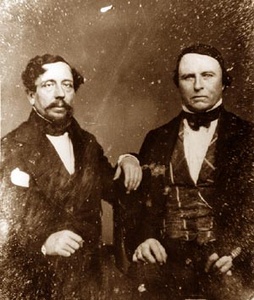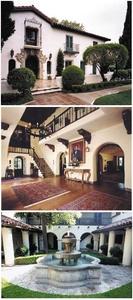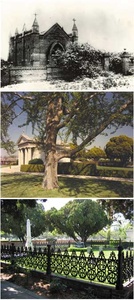 Workman House, ca. 1870. From the Homestead Museum collection.
Workman House, ca. 1870. From the Homestead Museum collection.
The Homestead Museum is a six-acre historic site located in the City of Industry on what was once part of a nearly 49,000-acre Mexican-era rancho called Rancho La Puente. The rancho was co-owned by the Workman and Rowland families. The museum features the Workman House, La Casa Nueva, El Campo Santo (the family cemetery), gardens, and a beautiful pond. History of the formation of the area from the time it was still under Mexican rule through the Roaring Twenties is its focus. The museum offers history-filled tours of the homes and property, as well as special events throughout the entire year. There is also a family mausoleum in El Campo Santo that holds the remains of members of the Workman and Temple family as well as family friend, Pío Pico, who was the last governor of Mexican California.
 Top: Jonathan “Juan” Temple, ca. 1850. From the Los Angeles Public Library. Bottom: Rancho Los Cerritos adobe, constructed in 1844 by Jonathan Temple. From the Los Angeles Public Library.
Top: Jonathan “Juan” Temple, ca. 1850. From the Los Angeles Public Library. Bottom: Rancho Los Cerritos adobe, constructed in 1844 by Jonathan Temple. From the Los Angeles Public Library.
Family History
The first member of the families to settle in Southern California was Jonathan Temple. A native of Reading, Massachusetts, Temple lived in Hawaii and San Diego before opening the first American-style store in Los Angeles in 1828, which he operated for almost thirty years. He was also one of Los Angeles's first developers, constructing such landmarks as the original Temple Block and the Market House, which later served as city and county administrative headquarters, contained the county courthouse, and featured the first true theater in Southern California. He also served as the first alcalde, or mayor of Los Angeles after capture of the pueblo by the United States during the Mexican War and served on the first American-period common (city) council.
Jonathan’s younger half-brother, F.P.F. Temple, came to settle in the Los Angeles area in 1841, the same year that William and Nicolasa Workman, and their children Joseph Manuel and Antonia Margarita, arrived from Taos, New Mexico. Workman, an immigrant from England, seems to have made a good living in Taos, but politics soon made life difficult, motivating the family to move further West. The Workmans quickly established themselves as cattle ranchers, but after a series of floods and droughts, the family began growing wheat and grapes for wine production. They built a modest house, which they remodeled twice. Its current appearance reflects the most dramatic changes that were completed by 1870.
A few years after settling in the area, William Workman found himself embroiled in politics once more. He was the captain of a group of white volunteers serving Pío Pico in his successful effort to unseat unpopular governor Manuel Micheltorena. Perhaps as a result of his assistance, Workman received several grants of land from Pico, including the islands Alcatraz and San Clemente, the missions San Gabriel and San Rafael, and the above-mentioned regranting of Rancho La Puente. In the American takeover and subsequent land claims process, however, only the latter remained in Workman's hands.
The Workman and Temple families were united through the marriage of Antonia Margarita to F.P.F. Temple. Their wedding in 1845 was the first nuptial in Southern California history where both parties had Anglo last names. The couple had 11 children, 8 of whom lived into adulthood. Unfortunately, a failed bank investment in 1876 led to the loss of most of the Workman and Temple family's wealth and land by the turn of the century.
Walter P. Temple, tenth child of F. P. F. and Margarita Temple and grandson of William and Nicolasa Workman, brought a resurgence of his family in regional affairs through oil, real estate and construction, and philanthropy in the 1920s. He was a struggling walnut farmer on the family homestead at La Merced, where he lived with his wife Laura Gonzalez and their four surviving children. In 1917, Walter and Laura used their wealth from an oil discovery to repurchase 75 acres of the family's original rancho, and soon they commissioned architects to design La Casa Nueva, or "The New House."
In 1923, Walter founded the Town of Temple, known today as Temple City. Sadly, like the Workmans, the Temples lost their wealth through failed investments, and lost the Homestead to foreclosure in 1932.
 William Workman (right) and friend David W. Alexander, ca. 1851. From the Los Angeles Public Library.
William Workman (right) and friend David W. Alexander, ca. 1851. From the Los Angeles Public Library.
 Top to bottom: Front entrance, Main Hall, and Courtyard of La Casa Nueva.
Top to bottom: Front entrance, Main Hall, and Courtyard of La Casa Nueva.
Houses and land turned Museum
The Workman House is listed on the National Register of Historic Places and is a California State Historic Landmark. The house originally stood as a simple three-room adobe, built shortly after the Workman family's arrival in November 1841. With the success of their cattle ranch, they continued to remodel the house by adding rooms. By the 1870s, new wealth from vineyards and wheat farming allowed them to completely transform the Mexican-era adobe into a modern American house, building a second floor and adding a variety of decorative details. Believed to have been designed by early Los Angeles architect Ezra Kysor, the picturesque country home reflects the architectural tastes that were popular in mid-nineteenth century America. What makes the house so unique is that the original three rooms of the adobe house are still part of the structure. A section of the original adobe wall can still be seen during the tour of the house.
In 1917, Walter P. Temple and his wife Laura used their wealth from an oil discovery to repurchase 75 acres of the family's original rancho. The Temples soon commissioned well-known Los Angeles architects Walker and Eisen and later Roy Seldon Price to design La Casa Nueva, or "The New House." Built between 1922 and 1927, this 12,400-square-foot Spanish Colonial Revival mansion is noted for its fine architectural crafts, including stained glass, ceramic tile, wrought iron, and carved plaster and wood.
By the early 1930s, the Temple family lost the house to foreclosure. The property was used as a boys' military school and a convalescent hospital before the City of Industry purchased the property in the 1960s and '70s. Following several years of restoration, the museum opened in May 1981.
 El Campo Santo from Workman and Temple family homestead Museum collection
El Campo Santo from Workman and Temple family homestead Museum collection
On the grounds is also a family cemetery. It is one of the oldest private cemeteries in Southern California. El Campo Santo, or "The Sacred Ground," contains the remains of Workman and Temple family members, as well as Pío Pico, the last governor of Mexican California. In the early 1850s, the Workmans established El Campo Santo as a cemetery for their personal use. Along with a fenced-in burial plot, they built a Gothic Revival brick chapel dedicated to St. Nicholas by Bishop Thaddeus Amat of Los Angeles. The chapel was destroyed by fire in the early 1900s and the Temples constructed a mausoleum in its place.
FAQS
Please check hours prior to visiting!
The museum offers free tours of the houses and grounds on Wednesday-Sunday at 1:00, 2:00, 3:00, & 4:00 p.m. Please check all hours before visiting.
Tours of the Workman House are at 1:00 & 3:00 p.m. Tours of La Casa Nueva are at 2:00 & 4:00 p.m. Tours of each house last up to 45 minutes.
El Campo Santo cemetery is open Monday-Friday from 9:00 a.m. to 5:00 p.m., and Saturday and Sunday from 12:30-5:00 p.m.
Tours of El Campo Santo cemetery are self-guided and a pond filled with koi fish and turtles is nearby for exploring. Please check all hours before visiting.
FAQs: https://www.homesteadmuseum.org/about-us/faq
Museum introductory video: https://www.youtube.com/watch?v=c9BcBe2ikLs
For more information please visit:
https://www.homesteadmuseum.org/home


